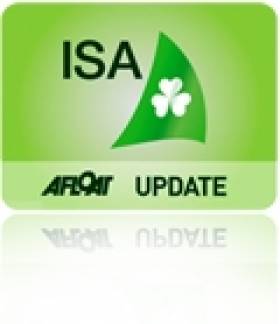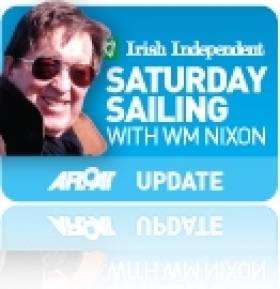Displaying items by tag: Annalise Murphy
ISA Chief Sees Bright Future for Irish Sailing
#IRISH SAILING - Irish Sailing Association (ISA) chief executive Harry Hermon took time out from the ISAF annual conference in Dublin this week to talk to Sport for Business about the growth of sailing in Ireland.
“2012 has been in many ways a breakthrough year for the sport,” he said. “We hosted so many major events during the year, from the Volvo Ocean Race finale in Galway to the World Youth Championships on Dublin Bay and of course it was an Olympic year and we had our strongest performance for many years.”
Aside from building on commercial partnerships, Annalise Murphy's near-medal-winning performance at the London Olympics was a boon for the profile of sailing in the public's imagination, and Hermon intends for the ISA to capitalise on this in the years to come, both for the Rio Games in 2016 and beyond.
“20,000 young people are coming through certified courses each year and staying with the sport," he said. "In addition we are reaching out to tens of thousands more through multi-activity camps ‘on the water’ around the coastal and inland waterways that are such an attribute in Ireland.
“We have a sport that enables 18-year-olds to race alongside their grandparents and few can offer such a crossover appeal.”
Sport for Business has much more on the story HERE.
Busy Days Ahead for Olympic Star Annalise Murphy
#ANNALISE MURPHY - The Daily Sail reports on a busy few days ahead for Irish Olympic sailing star and August Sailor of the Month, Annalise Murphy.
As previously covered on Afloat.ie, the 22-year-old - who scored Ireland's best Olympic sailing result in 32 years at London 2012 in the Laser Radial class - will today join the crew of the Omani MOD70 yacht Oman Sail-Musandam in Dublin Bay as part of the MOD70 European Tour, in celebration of the 19th anniversary of the Round Ireland speed record set by the late Steve Fossett.
Meanwhile, Murphy is also busy supporting her fellow UCD students selected as Ireland's representatives in the 2012 Student Yachting World Cup, to take place in La Rochelle, France late next month.
Murphy, who returned to UCD this week to complete the degree in science she deferred for her Olympic training three years ago, said: “I’m great friends with the guys on the team from either sailing or my first year in UCD.
"They’re a really strong team and have a really good chance of winning at the World Cup. I wish them the best of luck."
Annalise Murphy is Sailor of the Month for August
#sailor of the month – Annalise Murphy of the National YC in Dun Laoghaire is the Irish Afloat.ie/Irish Independent "Sailor of the Month" for August following her outstanding performance in the London Olympics. The talented and dedicated 22-year-old had the entire country in thrall as she battled with the fierce challenge of being top of the Women's Laser Radial class, and her fourth place overall, shy of a medal by fractions of a second, is the best Irish Olympic Sailing Result for thirty years.
Merely to describe her result as fourth overall fails completely to capture the essence of Murphy's performance. For about half of the regatta, she was in the Gold Medal slot. Then having slipped down to bronze rankings, she regained the top place with only one race to sail.
At this level of sailing, being top leaves a helm open to all sorts of joint challenges by those nearest in rankings. Like it or not, this is the way it is in sailing. Because there are ten boats involved, and with the wind being the motive power, the opportunities to block off a clear breeze or create other distractions for those heading the points table are there for the taking. When a leader is slowed back by one boat, two or three others can climb up the rankings at the previous leader's expense.
With four of the world's top women sailors in contention for the Gold going into that final race, the pressure was unbelievable. And with the race being staged in the fluky breezes close in off the Nothe at Weymouth, tiny gains could suddenly become significant gaps through vagaries of the wind.
It tells us everything about the stratospheric level of sailing in the Olympics that despite conditions which would have seen club racers spread over a wide time band, the Women's Laser Radials were finishing in tight order. But within that order, it was the Irish girl who - after leading for most of the series - lost out in the final leg.
But despite the outcome, throughout Ireland - maybe for the first time - people fully appreciated what is involved. Through her achievements and popular appeal, Annalise Murphy did more to raise the profile of our sport than any other Irish sailor in this extraordinary year, or indeed for many years.
DUBLIN BAY SPEED SAILING SUPERSHOW NEXT WEEK
The National Yacht Club, current Mitsubishi Motors Sailing Club of the Year, is setting a hectic pace throughout 2012, and tomorrow sees the international sailing focus swinging towards the club in its hospitable corner of Dun Laoghaire harbour as the European Tour of the five new MOD 70 class boats gets going from Kiel on Germany's Baltic coast, racing north round Scotland and on towards Ireland and the NYC in Dun Laoghaire.
Back in July, these 70ft trimarans leapt into prominence with their first major race, the Krys Transatlantic from New York to Brest. Not only did they see two of the boats average better than 25 knots across the pond to establish a new Transatlantic record, but they arrived in good order nicely on time for Bastille Day, and just after Groupama had won the Volvo Race for France. For the French sailing community, it was as good a Bastille Day as anyone could remember.
Since then, other nations have been making the global sailing headlines with the Olympics, and more recently the acceleration of the America's Cup programme in San Francisco. But as of tomorrow, France and the mighty MOD 70s will be top of the bill. They'll be in and around Dublin Bay from 5th to 9th September. After the rather sedate Parade of Sail which concluded the visit of the Tall Ships last weekend, next week we're going to have the opportunity to see sailing in which "sedate" will most emphatically not be the mot juste.

A Centenarian on the silver sea – Ainmara has been stepping out in style for her hundredth birthday. Photo: W M Nixon
SPRITELY CENTENARIAN GOES ISLAND-HOPPING
We took a break from last weekend's posting to go off with Dickie Gomes for the Centenary Cruise of his 1912-built 36ft yawl Ainmara. Those who knew Tiger Gomes in his glory days as a round Ireland record-maker and ace skipper of some notable top end offshore racers may not be aware that, since 1966, he has also been the owner of Ainmara, the first yacht designed and built in Ringsend by John B Kearney.
Admittedly the demands on the Gomes sailing talent were such that Ainmara spent many years as the sleeping princess in a shed at the Gomes farm. But with the Centenary coming up, her prince bestirred himself, she was put afloat for the first time in 28 years last year, and for this season a Centenary Cruise to familiar stomping grounds in the Hebrides was mooted.
It was back in 1960 that I made my first charter cruise in Ainmara to the Scottish west coast. She seemed quite an old boat then, at the age of 48, so getting the head round the fact that she's now a hundred takes a bit of doing. Although these days she carries a Bermudan rig with three headsails on an alloy mast which Dickie built himself back in the 1960s, her hull is still almost totally original, and even her rather brutal coachroof (you get used to the look of it) is simply built on top of the original cabin – this was a tasty little low profile effort, but it provided zilch in the way of headroom.
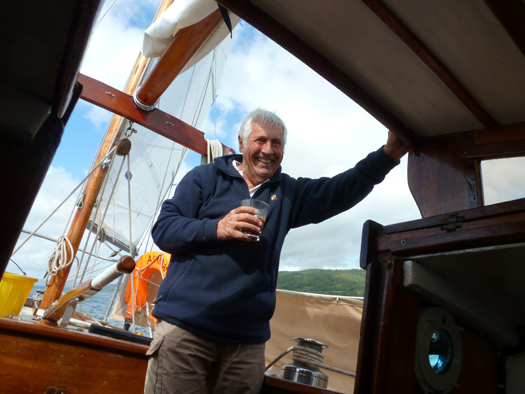
Dickie Gomes, Round Ireland Record Holder 1986-1993, relaxing aboard his beloved hundred year old Kearney yawl Ainmara in the Sound of Mull, August 2012.
I joined Dickie and his shipmate Denis Fusco (son of legendary sailor the late Victor Fusco) in Ballycastle on Tuesday August 7th. Ballycastle with its much-improved harbour is to Ireland's northeast corner as Kilmore Quay is to the southeast – a mighty-handy point of departure. I'd hopped on the DART that morning in Howth, yet that evening we were comfortably ensconced in the Ardview Inn at Port Ellen on Islay, starting to meet a continuous line of intriguing characters which continued throughout the Hebrides – with so many samey looking boats around these days, when you arrive in with a eccentric-looking Centenarian like Ainmara, it's a very effective calling card.
By going to the Hebrides, we got into the good weather which the areas well north of the jetstream have been enjoying for much of the summer. There's actually a water shortage in the isles. Inevitably with such weather the wind was lacking at times, hut we'd some marvellous sails, memorably trundling up the sea of the Hebrides with the jib tops'l and mizzen staysail added to the basic four sails.
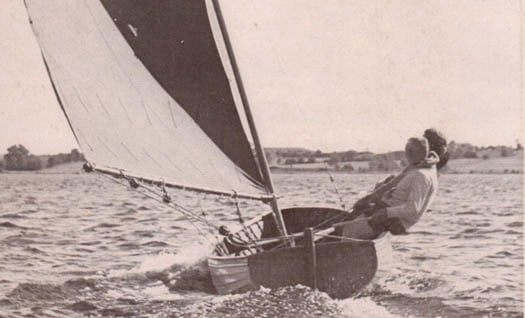
Summertime for an old boat and an even older castle – the Centenarian Ainmara wafts about a visitor's mooring off Kissimul Castle, the ancient stronghold of the MacNeils, at Castlebay in Barra in the Outer Hebrides. Photo: W M Nixon
In all, the spritely Centenarian got to twelve islands in twelve days, our furthest north being Harris where we treated ourselves to a centenary dinner in Donald MacDonald's hospitable inn beside the enchanting little anchorage of Rodel. When that bit of filthy weather swept through Ireland on Wednesday August 15th, we were far enough north to be roaring along towards the Kyle of Lochalsh in a sunny easterly which gave us a smooth water speed burst of 7.8 knots, yet without trailing a roaring quarter wave behind us – John Kearney surely knew how to create a sweet hull.
Even Dickie Gomes is not as young as he used to be, but until this cruise he'd disdained the old man's rig of mizzen and headsails only, with the main kept neatly furled. But with a brisk westerly as we came down down the Sound of Mull, and just the two of us aboard as Denis the Gentle Giant had left ship as planned at Mallaig, he gave the OMR a try, and Ainmara obliged by effortlessly notching 6.7 knots as a squall came off the dark Mull hills.
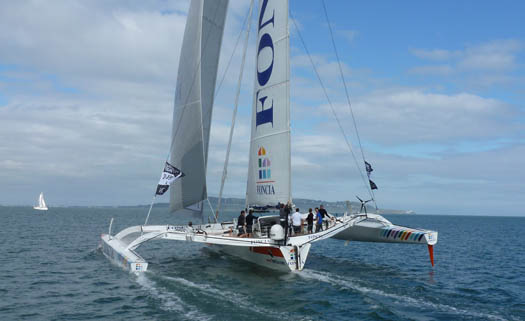
Grand breeze – Ainmara sails in style up Loch Carron in Wester Ross
A new crew joined at Oban on Monday while I returned to Howth via Donegal (that's another story), and Ainmara is now back at her moorings at Ballydorn off the Down Cruising Club's lightship headquarters in Strangford Lough. The lightship is also celebrating her centenary this year – she was built on the north side of the Liffey in 1912 when Ainmara was being completed at Ringsend on the south side. A Centenary Party will be staged this month, and beyond that cruising plans for 2013 are already taking shape – cruising a boat aged 101 will probably be even more entertaining than cruising an ordinary Centenarian.
#laser – A highlight of the Laser class National championships at the National Yacht Club in Dun Laoghaire has to be Annalise Murphy's performance in her first event ever sailing the bigger standard rig as opposed to her usual Radial rig with two race wins yesterday in the tough conditions. The event has seen some great racing between five Olympians in the standard rig. The event sponsored by VonZipper sunglasses have reached their half way stage on Dublin Bay yesterday with 6 races completed by the standard rigs and 5 by the Radial and 4.7 classes.
Being run over 4 days this week by the National Yacht Club in Dun Laoghaire, the large entry includes 4 of the Irish London Olympic Sailing Team - Laser men's representative James Espey, Laser Women's helm Annalise Murphy, 49er Helm Ryan Seaton and 470 crew Scott Flanagan - and Volvo round the world race officer Bill O Hara all in the Standard rig class. The opening day on Thursday saw light southerly and shifty winds and Friday gave excellent racing with a 15 knot steady easterly breeze. The 4 Olympians have dominated the first 2 days along with local sailor Mattie O'Dowd.
The event continues today and Sunday with five more races scheduled. Results available here. Laser National Championship photos are here.
#laser – London Olympian Annalise Murphy who scored Ireland's top Olympic sailing result for 32 years earlier this month in Weymouth made a welcome return to her home waters of Dublin Bay yesterday to compete in the first race of the Irish Laser National Championships hosted by her home club the National Yacht Club. Scroll down for the first day's action captured by photographer Aidan Tarbett.
Sailors Welcomed to NYC for Irish Laser Nationals
#LASER - The Irish Laser National Championships begin today in Dun Laoghaire running till Sunday 26 August, and the National Yacht Club has posted all the details Laser sailors will need regarding their visit for the weekend's competition.
Aside from the parking and event info are the all-important social arrangements for competing sailors, kicking off with a welcome barbecue after today's racing with a selection of burgers, spit roast and chicken. Tickets are €10 and available at registration.
Tomorrow will see the NYC AGM at 5pm after the racing in the JB Room, followed at 6.30pm with a special reception for Laser Radial Olympian Annalise Murphy - not to mention soup and rolls for the hungry sailors after their day on the water.
On Saturday the fleet will be treated to a pasta dish coming off the water, followed by a Tall Ships farewell evening in the Docklands. And Sunday's post-competition activities include the prizegiving ceremony and a farewell barbecue.
Full details for Laser sailors are available on the National Yacht Club website HERE.
#olympic – Annalise Murphy's achievements in London 2012 a week ago along with the performances of her team mates will be celebrated at a special homecoming event for the Irish Olympic sailors at the National Yacht Club in Dun Laoghaire tomorrow.
Annalise's Dun Laoghaire club is the venue for the 2012 sailing team reception. Although the sailing team did not deliver the much sought after medal from Weymouth it captured the attention of the nation when Olympic debutante Annalise took an explosive lead in the Laser Radial class and brought home Ireland's best Olympic sailing result in 32 years, finishing fourth.
The successful Irish Olympic team returns to Dublin tomorrow at lunchtime after a medal haul that equals that of the Melbourne Olympics in 1956. Five medals came from boxing and equestrian sports. On arrival there will be a private team reception at the airport followed by a press conference before the athletes go their separate ways.
The Irish Olympic Sailors achieved the following results: Laser Radial – Annalise Murphy 4th overall; Star – Peter O'Leary & David Burrows 10th overall ; 49er – Ryan Seaton & Matt McGovern 14th overall ; 470 – Ger Owens & Scott Flanigan 23rd overall; Laser – James Espey 36th overall.
Tomorrow's homecoming event at 5pm at the National YC is being hosted by the Irish Sailing Association (ISA). The association says it is 'an RSVP event for families and friends of the sailors and not a public event'
Read WM Nixon's post Olympic regatta column here
Annalise Loses Out on Medal in Thrilling Olympic Finale
#Annalise_murphy – There was Olympic heartbreak for Annalise Murphy on one of the toughest race courses today when the 22–year–old Dun Laoghaire sailor finished fourth overall but only after a tense four way battle saw the Irish Olympic debutante lose out in the final moments of the 50 minute medal race.
The downwind finish was ultimately a tough leg for one of the biggest girls in the fleet. Nevertheless the sporting moment provided not only sailors but the entire country with a great lift when the Irish girl arrived in gold medal position at the first windward mark.
"Hard luck Annalise. You did us proud. Seeing the tricolour come around the first mark in gold medal position was as good as Packie Bonner's save or Dave O'Leary's penalty at Italia 90", wrote one reader on Afloat.ie
Murphy finished the race fifth to be fourth overall. Though there is no Irish medal it is Ireland's best Olympic sailing result in 32 years. Understandably that will be of small consolation to an emotional Annalise in Weymouth this afternoon.
Ashore after racing Annalise said "Coming fourth was definitely the worst result. "I kept losing out downwind because I kept going left downwind and there was less wind. Things just didn't work my way".
"I'm only 22. I'm going to work so hard and be back for 2016", a tearful but positive Annalise said.
In a set of conditions that could not have been more different to those that blasted Annalise into the lead of the Olympic regatta last week, Ireland's Annalise set sail on her final voyage for Gold in Weymouth in 12 knot westerlies and sunshine.
Going in to the medal race Annalise was third overall on 34 points with arch rival Van Acker from Belgium. The lead was held jointly by Liljia Xu and the world champion Marit Boumeester both on 33 points. Paddy Power bookmaker gave odds of 11/4 to Annalise. Boumeester was on 9/4, Liljia Xu 5/2 and Van Acker 11/4.
A tense four-way battle loomed as Ben Ainslie's girlfriend Marit Boumeester of Holland, the reigning radial world champion went for a matching Gold medal.
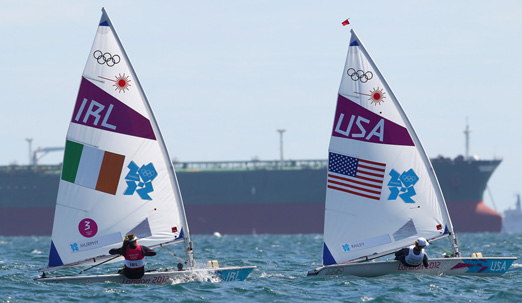
Annalise chases bronze medal position in the medal race today. Photo: Richard Langdon
Annalise had a mid line start in the stable 12 knot breeze and her upwind speed was clear to see. The Irish girl rounded the weather mark first but China's Lijia Xu quickly passed her on the run. Annalise appeared slow downwind, dropping eight places by the first leeward mark.
China rounded ahead of Holland's Marit Bouwmeester going into the second lap of the race. The other contender Van Acker of Belgium was last with Annalise in seventh place.
But by the top of the second weather mark Annalise was back in silver medal position again storming upwind just behind China with Van Acker on her heels in third having gained on the right.
But Annalise dropped back again on the second run. Boumeester motored down the run into second for the last lap, pulling the rabbit out of the hat downwind.
Annalise rounded the leeward mark for the second time fifth and out of the medals. But on the final upwind leg Annalise was again back in contention. The Dun Laoghaire sailor and Van Acker dueling for Bronze as Xu and Boumeester fought for gold and silver.
One thing was for sure, the Nothe course was never boring with places changing on every leg in the 12-14 knot winds.
On the final downwind leg Annalise was in bronze medal position with Van Acker two boats behind in sixth.
All four sailors from all four nations were neck and neck in the last few moments of the race. Thirty seconds or so separating the top five boats. Crafty Van Acker sailed back in to contention catching a series of good gusts leaving Ireland with Olympic agony just metres from the finish line.
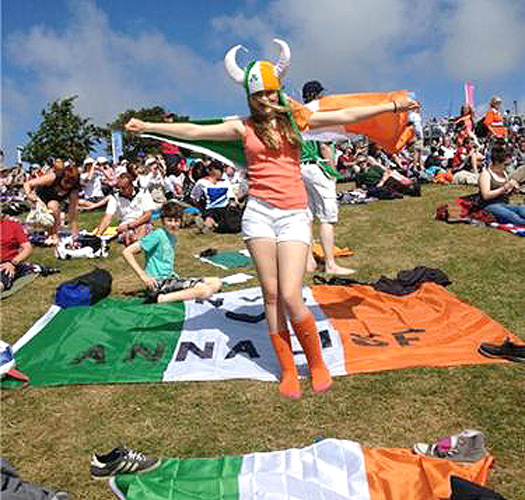
Irish fans were out in force in Weymouth, 'Annalise's army' positioned right in front of the Nothe course. Photo: Finn Murphy
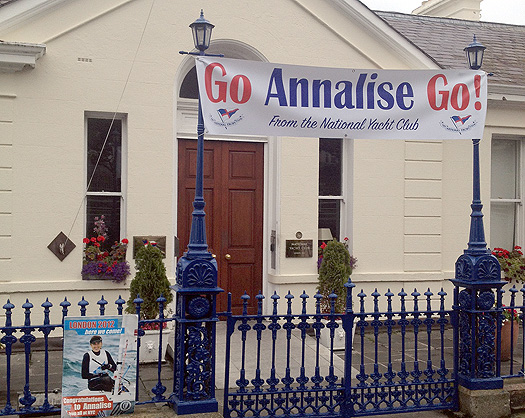
Annalise's club, the National Yacht Club on the East Pier in Dun Laoghaire, had the bunting out for today's medal race and her sailing students were jumping for joy all week. Photos: Michael Chester
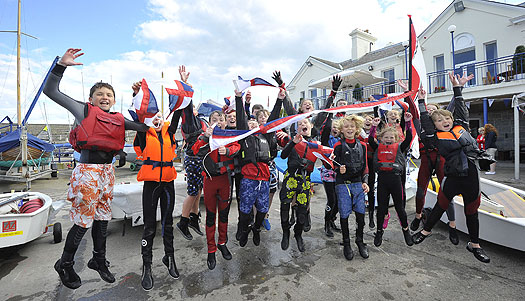
#annalise_murphy – Annalise Murphy has posted the best Olympic sailing result for Ireland in 32 years following this afternoon's final races of the Laser Radial class in Weymouth with only a single point now separating the top four boats.
The 22–year–old Olympic debutante is in the mix for the Gold medal in Monday's medal race and cannot finish worse than fifth overall.
On coming ashore this evening the National Yacht Club sailor said that although she could finish 1, 2, 3 or 4 she was still hopeful it would be first but she was ready for anything. She also said she was expecting a difficult medal race in less than 48 hours time with both the Olympic champion and world champion also in the hunt.
Annalise is now joint third overall on 34 points with arch rival Evi Van Acker from Belgium. The lead is now held jointly by Lilia Xu of China and the world champion Marit Boumeester of Holland.
If Annalise beats any one of Xu, Van Acker or Boumeester on Monday she will win a medal.
Annalise was at the centre of a thrilling climax in the fleet racing this afternoon scoring a 2 and a 7 in lighter winds and tricky conditions. Murphy proved to be a most consistent sailor following up her early regatta wins with two solid performances to secure her medal race berth ahead of Belgium's Evi Van Acker of Belgium and world champion Marit Van Bouwmeester of Holland.
The UCD student briefly regained her position at the top of the Laser Radial fleet in what was a dramatic Race 9 at lunch time. Two general recalls saw her opponent Alison Young (GBR) disqualified along with the sailors from BLR, NZL, GER, TUR and IOA. Annalise got off to a great start at the top of the fleet in 5th. By the third mark she had taken 40 seconds off the Chinese leader to lie in 2nd place. She continued to fight hard within the top three against Xu (CHN) and Cebrian (ESP) to finished in 3rd place, reclaiming her spot as 1st overall. Her closest competitors Bouwmeester (NED) finished 6th while Van Acker (BEL) finished in 8th which gave Murphy a four point lead on 2nd place overall Van Acker and 3rd place Xu who both had 31 points to Murphy's 27.
Race 10 certainly proved to be a nerve racking way to finish the fleet racing. The first five boats to round the first and second marks were the top five medal contenders; Murphy (IRL), Van Acker (BEL), Xu (CHN), Bouwmeester (NED) and Young (GBR). Murphy then separated from the rest of the fleet taking the right hand gate while the others went left. It was a risky move but her gutsy tactics kept her in the top five. She then had a tough reach to the fourth mark and slipped back to 7th and stayed there, costing her the overall lead. Murphy finishes the fleet racing in 3rd overall with just an incredible one point separating the top four sailors. As the medal race is worth double points everything will hinge on Monday's race. Leader Xu (CHN) is on 33 points, in 2nd is Bouwmeester (NED) also on 33 points, in 3rd is Murphy (IRL) on 34 points and in 4th is Van Acker (BEL) also on 34 points.
The Laser Radial Medal race will be broadcast live by RTE on Monday lunchtime at 1300hrs.
Follow Afloat on twitter for latest Annalise medal race updates
Annalise Stays on Course for Olympic Gold
#annalise_murphy – One point off the overall lead in the Laser radial class Annalise Murphy, Ireland's best hope for a sailing medal, continued her campaign unabated yesterday when she sailed again at the top of the fleet in her first race of the day. The performance of the Irish Olympic debutante to lead the regatta after four days of racing against Olympic and world champions is nothing short of remarkable.
Today's final two fleet races are crucial with so many consistent peformers at the top of the fleet. The top three sailors overall are on 23, 24 and 26 points respectively. Annalise will be mindful of any result scored outside the top 20 that could put her out of medal contention.
She maintained pole position until the third mark when Lijia Xu (CHN) edged in front of her.
The pair continued to battle it out for the top spot for the rest of the race, never allowing the other competitors to challenge them. Ultimately it was Xu (CHN) who crossed the line in first place but she was followed by Murphy in a close second. It was a major result because Murphy's main rivals Bouwmeester (NED), Young (GBR) and Van Acker (BEL) finished 4th, 6th and 8th respectively meaning Murphy extended her lead to eight points.
In Race 8 yesterday afternoon Murphy finished in 10th place to lose pole position for the first time in the competition. She's now second overall but only one point behind Van Acker (BEL) on 24 points and with the final two fleet races today.


























